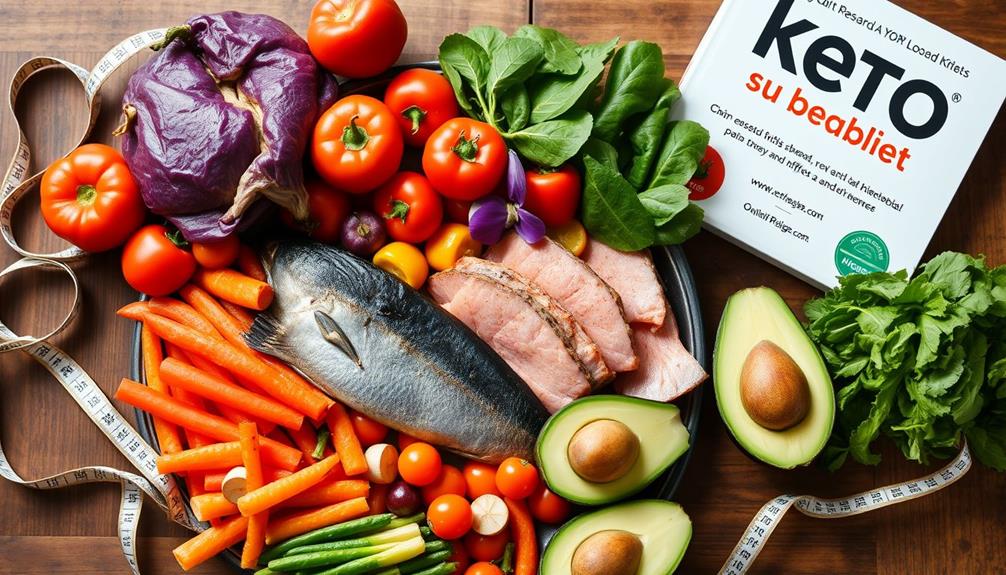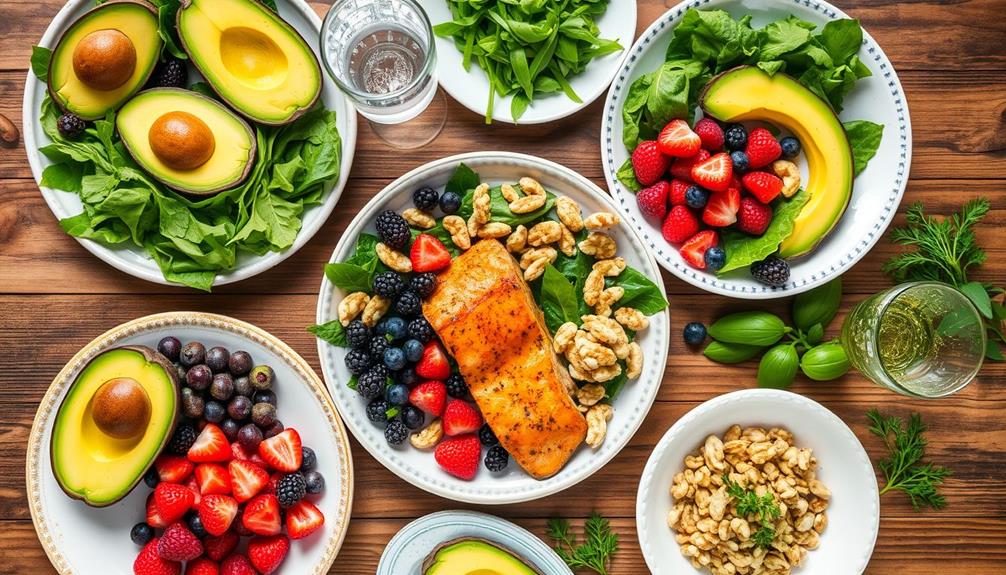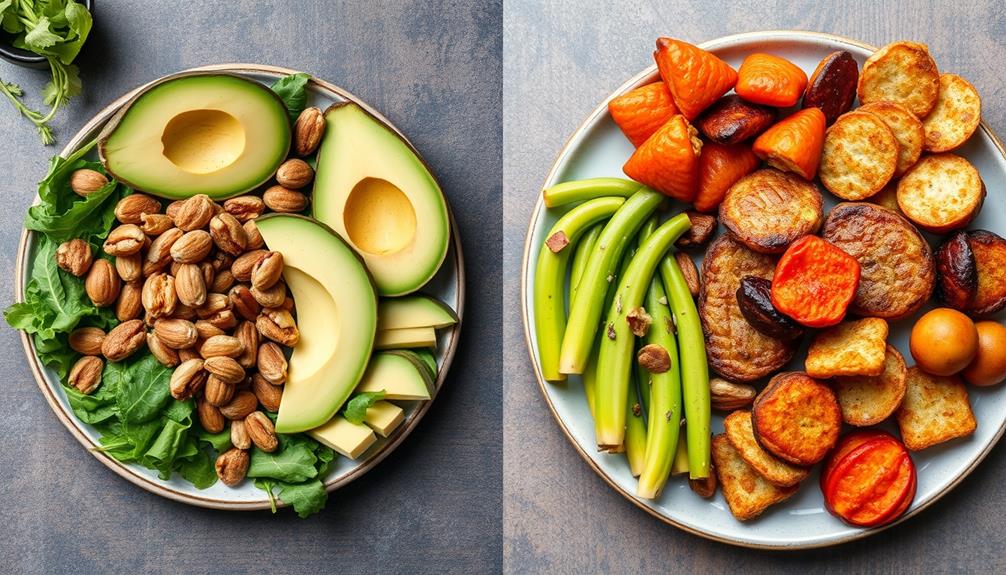To do the keto diet right, focus on high-fat foods like avocados, nuts, and fatty fish while keeping your carbs under 50g a day. Aim for about 70-80% fat, 15-20% protein, and minimal carbs. Stay hydrated and boost your electrolytes to avoid the "keto flu" symptoms like fatigue and headaches. Opt for nutrient-rich, low-carb vegetables to keep your meals balanced. Meal planning is essential to stay on track, and monitoring your macronutrient intake can help guarantee you're staying in ketosis. There's plenty more to discover about making this diet a sustainable success!
Key Takeaways
- Follow a macronutrient ratio of 70% fat, 20% protein, and 10% carbohydrates to maintain ketosis effectively.
- Stay hydrated by drinking 2-3 liters of water daily and balance electrolytes to alleviate keto flu symptoms.
- Incorporate nutrient-dense, low-carb foods like leafy greens, healthy fats, and quality proteins to avoid deficiencies.
- Track your food intake using apps or journals to ensure adherence to your keto goals and adjust as needed.
- Plan meals in advance to avoid high-carb temptations and maintain a variety of flavors in your diet.
Understanding the Keto Diet

Have you ever wondered how the Keto Diet works? The ketogenic diet is a high-fat diet designed to help your body reach ketosis, a metabolic state where it burns fat for fuel instead of carbs. Typically, you'll aim for a meal plan consisting of 70-80% healthy fats, 15-20% protein, and less than 50 grams of carbs per day.
By cutting down on carbs, your body starts using fat as its primary energy source. It's crucial to verify that your diet is rich in nutrients, as nutrient deficiencies can be a concern when restricting food groups, similar to potential issues with juice diets.
Transitioning into ketosis can take anywhere from 7 to 30 days, and you might experience what's commonly known as the keto flu. Symptoms include fatigue, headaches, and nausea, but staying hydrated and increasing your electrolyte intake can help alleviate these issues.
To make the most of the keto diet, focus on incorporating high-fat foods like avocados, nuts, seeds, and fatty fish while avoiding sugary foods and grains. You can still enjoy low-carb fruits like berries.
Just remember to monitor your protein intake, as too much can hinder your progress. With the right approach, the keto diet can help you improve your metabolic health and achieve your weight loss goals.
Essential Foods for Keto

To succeed on the keto diet, knowing which foods to include in your meal plan is key. Focus on high-fat foods that should make up about 70% of your daily caloric intake. Incorporate avocados, nuts like macadamias and almonds, seeds, fatty fish such as salmon, and grass-fed meats. These foods are fundamental for maintaining your ketogenic diet and can help you avoid potential investment pitfalls that may distract you from your health goals.
Next, include low-carb vegetables like leafy greens—spinach and kale—as well as cruciferous options like broccoli and cauliflower. These help guarantee adequate fiber and nutrient intake while keeping your carbohydrate intake low.
Healthy fats are also vital; use olive oil, coconut oil, and butter to enhance flavor and provide energy. Aim for about 165 grams of fat daily on a 2,000 calorie diet.
Be mindful of what to avoid—limit starchy vegetables, grains, most fruits, and sugary foods, as they can hinder your shift into ketosis. When it comes to dairy, choose full-fat, unprocessed options like cheese and heavy cream, and watch your body's response to lactose since some may experience digestive issues.
Keeping these essentials in mind will help you thrive on your keto journey.
Health Benefits of Keto

The ketogenic diet offers numerous health benefits that can greatly enhance your well-being. One of the most notable advantages is weight loss; studies show participants on the ketogenic diet lose, on average, 2 pounds more than those on low-fat diets.
This initial weight loss often includes water weight, but sustained adherence can lead to consistent fat loss and improved metabolic health. Additionally, adopting a healthy diet can complement the keto approach, as seen in recommendations for managing other health conditions like cold medications overview.
If you have type 2 diabetes, the ketogenic diet may be particularly beneficial. Research indicates that around 60% of individuals with this condition experienced improved blood sugar levels and some even reversed their diabetes after adopting keto.
Moreover, the diet can help regulate insulin levels, making it a powerful tool for managing this disease.
You'll also find that the ketogenic diet can improve your cholesterol levels, reducing triglycerides while increasing HDL (good) cholesterol.
In addition, for those dealing with epilepsy, particularly drug-resistant cases, the ketogenic diet can greatly reduce seizure frequency by up to 50%.
With these various health benefits, the ketogenic diet can be a transformative approach to achieving your wellness goals.
Common Side Effects

Shifting into ketosis can come with its share of challenges, often known as the "keto flu." During this initial phase, you might experience symptoms like fatigue, headache, nausea, and brain fog, which typically last from a few days to a week.
These side effects occur as your body evolves from using glucose to burning fat for energy, producing ketones in the process. It's important to reflect on your overall budget for health foods as you plan your meals, ensuring you have the right ingredients to support your new diet.
It's essential to prioritize hydration and electrolyte balance during this time. Increased water loss and shifts in electrolyte levels can exacerbate symptoms.
Make sure you're consuming plenty of fluids and think about adding electrolyte supplements to help alleviate discomfort.
You may also face digestive issues, such as diarrhea or constipation, due to changes in your dietary fiber intake and increased fat consumption.
These issues usually resolve as your body adapts to the new diet. Additionally, keep an eye out for bad breath, a common occurrence caused by acetone, a type of ketone exhaled during ketosis, leading to a fruity or metallic smell.
Long-term Keto Management

Long-term success on the Keto diet hinges on adopting sustainable eating habits and closely monitoring your nutritional intake.
It's crucial to incorporate balanced diet principles that include a variety of nutrient-rich foods to support overall health.
You'll want to focus on whole foods to keep your meals clean while balancing your macronutrients properly.
Regular check-ins with your health are key to ensuring you're staying on track and maintaining good health.
Sustainable Eating Habits
Embracing sustainable eating habits is vital for maintaining a ketogenic lifestyle over the long haul. Focus on whole, nutrient-dense foods like leafy greens, high-quality meats, and healthy fats while limiting your low carbohydrate intake.
Incorporating essential oils for toothache relief can also enhance your overall wellness, helping you stay in ketosis and feel energized.
Consider adopting a ketotarian style, which incorporates vegetarian options while remaining low in carbs. This flexibility allows you to enjoy a variety in your diet without feeling restricted.
Regularly monitor macronutrient ratios to guarantee you're not overdoing it on fat or protein, which can disrupt your metabolic state.
Meal planning is essential for staying on track and adapting your meals as needed. Engage in ongoing education about nutrition to keep your meals interesting and to learn how to modify recipes. You don't want to fall into a rut with the same dishes.
Additionally, leverage community resources like online forums or local groups. Sharing experiences with others not only keeps you motivated but also helps you find new ideas for sustainable eating habits.
Monitoring Nutritional Intake
Tracking your nutritional intake is essential for successful long-term management of the keto diet. To maintain the proper macronutrient ratios—about 70% fat, 20% protein, and 10% carbohydrates—you'll need to keep a close eye on your daily intake, usually limiting carbs to under 50 grams.
Staying informed about evolving dietary trends and potential changes in nutritional science can also enhance your keto journey, especially by monitoring free crypto opportunities that may help you fund your health food purchases.
Here are some effective strategies to help you monitor your nutrition:
- Use nutrition tracking apps or food diaries to log meals and snacks.
- Regularly check blood ketone levels with a ketone meter or urine strips.
- Focus on incorporating a variety of low-carb, nutrient-dense foods.
- Consider supplementation to fill any nutritional gaps.
Tips for Successful Keto

To make your keto journey successful, focus on meal planning and hydration.
Incorporating coffee's role in wellness can provide a comforting routine while keeping you energized.
By preparing meals in advance, you'll steer clear of high-carb temptations and guarantee you're eating nutrient-dense foods.
Don't forget to keep your electrolytes balanced; staying hydrated is essential for avoiding those pesky keto flu symptoms.
Meal Planning Essentials
Meal planning for the keto diet revolves around choosing the right high-fat foods while keeping carbs in check. To achieve ketosis, you'll want to limit your carbohydrate intake to 20-50 grams per day.
It's important to be aware that emotional stability can play a significant role in maintaining a healthy diet, especially for individuals who may struggle with emotional dysregulation understanding emotional dysregulation.
Start by preparing your meals in advance to avoid the temptation of processed foods. Use keto-friendly recipes to keep things interesting and nutritious. For example, try making a large batch of keto-friendly soup or chili for the week, or prepare a variety of salads with plenty of low-carb veggies and protein. Another important aspect of a successful keto diet is staying hydrated and getting enough electrolytes, so be sure to drink plenty of water and consider adding in some sources of potassium and magnesium. These keto diet tips can help keep you on track and feeling great while enjoying delicious, wholesome meals.
Here are some essentials for successful meal planning:
- High-fat foods: Include avocados, nuts, seeds, and fatty fish.
- Non-starchy vegetables: Load up on leafy greens and cruciferous veggies for added vitamins.
- Macronutrient tracking: Use apps or food journals to guarantee you're hitting the recommended ratio of 70% fat, 20% protein, and 10% carbs.
- Keto-friendly snacks: Have options like cheese or olives on hand to stay on track.
Hydration and Electrolyte Balance
Staying properly hydrated is crucial when you're on the keto diet. As your body enters ketosis, it excretes more water and electrolytes, which can lead to increased urination and fluid loss. To maintain hydration, aim to drink at least 2-3 liters of water daily. This helps support overall bodily functions and keeps you feeling your best.
Additionally, keeping your furry friends hydrated is important as well; snacks like healthy dog snacks can provide hydration and boost their overall well-being.
Electrolyte balance is equally important. Supplementing with key electrolytes like sodium, potassium, and magnesium can help alleviate symptoms of the "keto flu," such as fatigue and muscle cramps. You can also incorporate electrolyte-rich foods into your meals. Foods like avocados, leafy greens, and nuts are excellent sources of these crucial nutrients.
Keep an eye on your hydration levels and adjust your intake based on your individual needs. If you find it challenging to get enough electrolytes through food alone, consider using electrolytes supplements or powders.
Frequently Asked Questions
What Is the Correct Way to Do the Keto Diet?
To do the keto diet correctly, you'll focus on high-quality fats, limit carbs to 20-50 grams, and maintain hydration. Gradually shift into the diet to avoid keto flu symptoms and monitor your ketone levels.
What Are the Basic Rules of a Keto Diet?
The basic rules of a keto diet involve limiting carbs to 20-50 grams daily, focusing on high-fat foods, and maintaining a macronutrient balance. Stay hydrated and monitor ketone levels for best results.
How Do I Start Successfully on Keto?
To start successfully on keto, visualize a lush avocado tree. You'll need to calculate your macros, plan meals around healthy fats, stay hydrated, and gradually cut carbs. Keep track of your ketone levels for progress.
How Does the Keto Diet Work for Beginners?
The keto diet shifts your body from burning carbs to burning fat by drastically reducing carb intake. You'll enter ketosis, but initial symptoms like fatigue may occur as your body adjusts to this new energy source.
Conclusion
In the world of diets, the keto diet can be your shining star if you approach it wisely. By focusing on essential foods, staying mindful of side effects, and planning for the long haul, you can reap its many benefits. Remember, it's not just about cutting carbs; it's about embracing a new way of eating. With a sprinkle of patience and a dash of determination, you'll find success on your keto journey—one delicious meal at a time!









